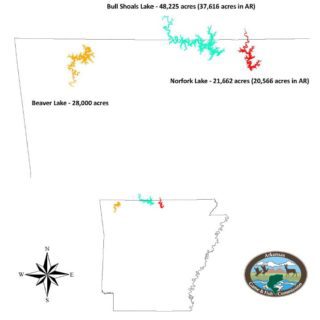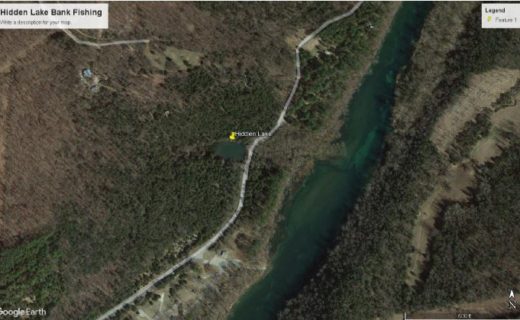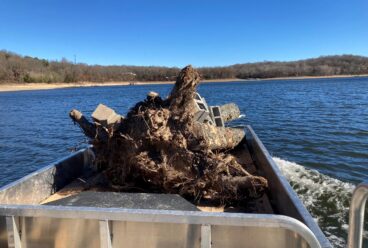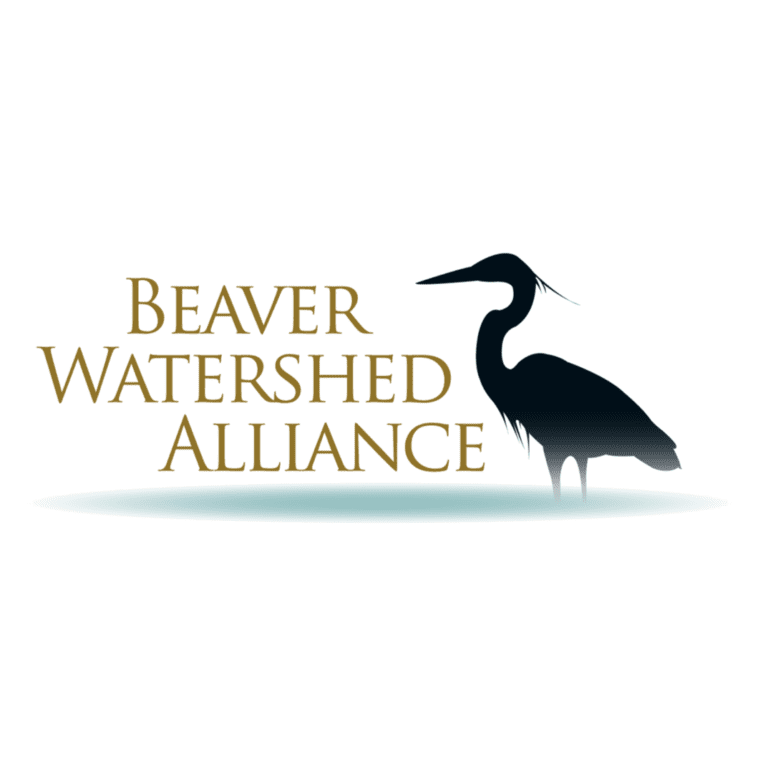Overview
-
Status
Ongoing -
Estimated Completion
2023 -
Location
Beaver Lake, Norfork Lake and Bull Shoals Lake -
Grants Received
$275,000 -
Total Budget
$1,301,400 -
Friends Group
Beaver Watershed Alliance -
Partners
Arkansas Game and Fish Commission, Beaver Watershed Alliance, U.S. Army Corps of Engineers

Reservoirs with high-quality fish habitats tend to have excellent spawns, high young survival, fast growth, and in some cases, require little additional management input, such as stocking or regulations. Unfortunately, having consistent quality habitat from year to year within reservoirs is rare due to reservoir aging. As reservoirs age, fish habitat quality decreases, leading to declines in the fisheries within reservoirs. This is particularly concerning since Norfork Lake was impounded in 1945, while USACE completed Bull Shoals and Beaver Lakes in 1951 and 1963. During the construction of these reservoirs, most of the vegetation that would have made excellent fish habitat was removed.
Why It Matters

Beaver, Bull Shoals, and Norfork Lakes are popular highland reservoirs in the White River watershed. In 2019, the USACE estimated 3,100,101 visits (person-days/nights) occurred on Beaver Lake, whereas 2,133,558 and 1,389,501 visits occurred on Bull Shoals and Norfork Lakes, respectively. Of those visiting Beaver Lake, 166,190 were by anglers, while 201,417 and 134,467 visits occurred by anglers on Bull Shoals and Norfork Lake, respectively. Also, the population of north Arkansas is booming, and the northwest part of the state is one of the fastest-growing populations in the U.S (the population size is expected to double from 500,000 people to over 1 million in the next 25 years).
Threats
For many years, anglers voiced concerns about the lack of fish habitat in the reservoir. In response, the AGFC initiated major natural fish habitat projects in 1987 on these reservoirs. The objective of these projects was to install fish habitats to significantly improve catch rates of sportfish by concentrating them during months when these species were historically widely dispersed. They believed improving angler success would enhance angler satisfaction, improve tourism, positively impact the local economy, and improve public opinion and involvement in fisheries programs. Over the years, the AGFC has established over a thousand fish habitat sites in these reservoirs. Unfortunately, many of these established fish habitat sites have deteriorated over time, making them inadequate for spawning, protecting the young, and foraging. Foraging habitat is critical as it directly affects anglers' success and satisfaction.
Fortunately, the AGFC Fisheries Division recognized the reservoir aging issue and the importance of fish habitat. The AGFC has made a concerted effort recently to replenish existing fish habitat sites while establishing new sites on Beaver, Bull Shoals, and Norfork Lakes. In 2017 and 2018, the AGFC completed large-scale habitat projects on Bull Shoals and Norfork Lakes. In 2021-2022, AGFC, with the help of at least 13 partners, conducted a large-scale fish habitat enhancement project on Beaver Lake, funded by the Reservoir Fish Habitat Partnership. The project garnered national recognition. While these projects helped establish and replenish fish habitat sites in these reservoirs, there are still plenty of areas that need attention. Our proposed projects will continue these fish habitat improvement efforts on Beaver, Bull Shoals, and Norfork Lakes.
What FOR Is Doing
The proposed project will directly benefit anglers by concentrating fish around fish habitat structures and improving angler success rates. Creel surveys on Beaver and Norfork Lakes indicated that most anglers utilize existing fish habitat sites (56% on Beaver Lake and 80% on Norfork Lake). Anglers also indicated that they catch more fish around these structures.
The proposed project will increase and improve bank angler access by adding parking areas and walking trails to the lake. Likewise, these access areas will be enhanced by adding fish habitat within casting distance to the bank fishing access. This will improve angler success and catch rates, and increase accessibility to anglers without boats.
Objective One: Beaver and Norfork Lake Fish Habitat Project
The White River Reservoirs have unique glade habitats located close to the shoreline of each lake. Glades are unique in that they contain some of the most diverse plant species in North America, however without prescribed fire they have become infested with cedar trees. The objective of the Beaver and Norfork Lakes Fish Habitat Project will be to improve fish, wildlife, and glade habitats on Beaver Lake, Beaver Lake Wildlife Management Area (WMA), and Norfork Lake by removing invasive Eastern Red Cedar trees. The trees will be placed in the lakes to improve fish habitat. Here are the goals that the AGFC will achieve to complete this objective.
AGFC staff will perform a large-scale fish habitat project on Beaver Lake over a two-week period. The project will incorporate at least 30 employees and 8 barges/boats to place 100 new fish habitat sites in Beaver Lake. Staff will utilize invasive red cedar trees from Corps property to place brush in the upper and middle sections of Beaver Lake. At least six large trees will be deployed per site. Standard 8” blocks will be attached to sink the structures. Staff will clear cedar trees from a glade on Shadox Island and cedar removal will improve native plant species by opening up the forest floor to sunlight. AGFC will target points, flats, and backs of coves that do not have any existing fish habitats to establish to provide nursery habitats for popular sportfish and provide fishing targets for anglers. At least 10 of the 100 sites will be placed close to campgrounds and public use areas to be utilized by shore anglers on Beaver Lake. The Norfork Lake Glade Restoration will encompass removing invasive cedar trees from a 7-acre glade. The trees will be placed in Norfork Lake for fish habitat. Cedar removal will improve native plant species by opening up the forest floor to sunlight. AGFC will target points, flats, and backs of coves that do not have any existing fish habitats to establish to provide nursery habitats for popular sportfish and provide fishing targets for anglers or existing fish habitat sites that need replenishing to remain viable for anglers.
Objective Two: Bull Shoals Lake Fish Habitat Project
The objective of the Bull Shoals Lakes Fish Habitat Project will be to improve fish habitat. Here are the goals that AGFC will achieve to complete this objective.
AGFC staff will perform a large-scale fish habitat project on Bull Shoals Lake over a two-week period. The project will incorporate at least 30 employees and 8 barges/boats to replenish or establish 100 fish habitat sites in the lake. Staff will utilize cedar and hardwood trees from USACE property to place in Bull Shoals Lake. At least six large trees will be deployed per site. Standard 8” blocks will be attached to sink the structures. AGFC will target points, flats, and backs of coves where existing fish habitat needs to be replenished to remain viable for anglers or needs to be established to provide nursery habitat for popular sportfish and provide fishing targets for anglers.
All sites will be marked with a GPS. Coordinates will be placed on the AGFC GIS Mapper website (https://apps.agfc.com/mapper/#8/34.780/-92.274 ) and made available on the AGFC Fish Attractor page (https://www.agfc.com/en/fishing/where-fish/fish-attractors/ ), which provides anglers with the opportunity to download the coordinates for their sonar devices and access habitat sites using their cellphones.
Objective Three: Beaver Lake Fishing Access Improvements
The objective of the Beaver Lake fishing access improvement project will be to improve bank fishing access on Beaver Lake. Bank fishing is very popular on Beaver Lake and with the increased population size in northwest Arkansas, it is projected that bank fishing will continue to grow going to be even more popular (population size expected to be 1 million people in 25 years). The AGFC and USACE-Beaver Lake Office identified three areas around Beaver Lake where fishing access can be improved for bank anglers. Here are the goals that AGFC and USACE will achieve to complete this objective.
Improve bank fishing access at two access points on Beaver Lake (Highway 12 and Pin Hook Accesses) and one small impoundment (Hidden Lake) below Beaver Lake. Improve fishing access by adding roads, walking trails, gravel parking lots, and gravel fishing areas at one or more of these sites. Adding at least 10 fish habitat sites close to these accesses to improve bank anglers’ fishing success.
Related News

Coalition receives $3.9 million to conserve, restore War Eagle Creek
A coalition will receive a $3.9 million grant to conserve and restore War Eagle Creek in Northwest Arkansas, U.S. Secretary of the Interior Deb Haaland announced Wednesday. “Nature is our […]

Habitat and fish added to Arkansas waters by the truckload in 2023 | Stuttgart Daily Leader
LITTLE ROCK — Arkansas Game and Fish Commission biologists created nearly 200 semi-truckloads of fish attractors in 2023, and hatchery trucks kept up the pace, pumping more than 9.1 million […]

First Week of Beaver Lake Habitat Project Funded by Bass Pro Shops!
The Arkansas Game and Fish Commission conducted a large fish habitat project on Beaver Lake. Twenty Commission employees worked the project and we targeted three different areas of Beaver Lake […]
Donate Today
to support similar habitat projects


